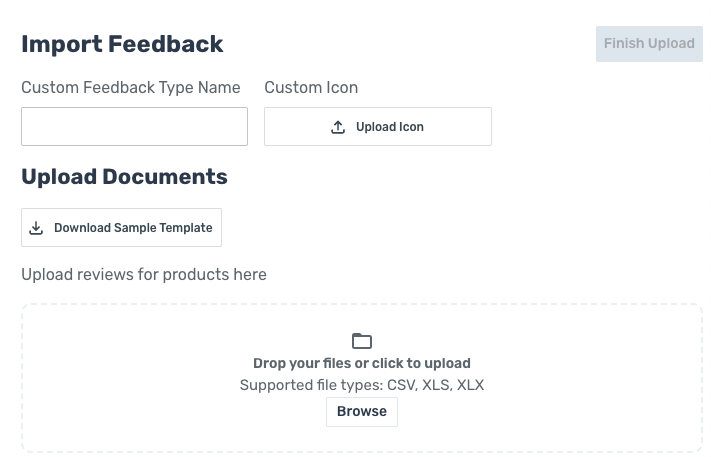Product Review Sentiment Analysis
AI-powered customer feedback so you can take action now
Native AI turns insight into impact
Introducing Native AI, the always-on market intelligence platform that helps you understand, innovate, and create ideal experiences for your customers.

A better way to find the answers you need
Create impact through measurable improvements to products, customer experience, and marketing.
-
Analyze millions of qualitative and quantitative data points
-
Automate product and keyword tracking across the web
- Converse with digital clones of your customers in real-time
Insights Dashboard
Customize and export reports with full choice of visualizations. Set up alerts for specific products and keywords, and monitor trends over time in order to predict future consumer behaviors and identify white-space opportunities.


Bring Your Own Data
Upload your first party data in any structured or unstructured format. Our platform is compliant with international data processing regulations to eliminate unnecessary risk.
Digital Twins
Converse with digital clones of your customers or your competitors' customers. Filter by demographic, purchase channel, behavior, and more. Create visualizations and export your results.

Expert White-Glove Service
Our platform is designed for you to be successful independently, but we're here to make sure you’re able to take full advantage of the value Native AI provides.
The Native AI Difference
We're not like other all-in-one insights platforms. Get a peek under the hood.
Data Safety & Privacy
Advanced Orchestration
Synthetic Output Controls
Product Review Sentiment Analysis
Product review sentiment analysis utilizes Natural Language Processing (NLP) in order to meticulously scrutinize the emotive nuances contained within customer feedback. This advanced technique deciphers whether a comment, opinion, or product review is positive, negative, or neutral, offering corporations profound insight into consumer perception and satisfaction. Industry leaders employ this cutting-edge mechanism to improve product quality, enhance customer relations, and gain a formidable competitive edge in increasingly saturated markets.
Product review sentiment analysis is actually a subsidiary of a larger umbrella — customer sentiment analysis. Customers will often review several products, which can give us an understanding of their preferences beyond a single product or brand. Because consumers are dynamic, this plethora of data points allows firms to more accurately target their marketing efforts, predict consumer behavior, and engage with their audience at a more personalized level.
There are many approaches to sentiment analysis. These range from simple rule-based systems that score text based on predefined sentiment-loaded words, to sophisticated machine learning algorithms that learn from a broad dataset of text, accurately encompassing human language's complexities. Others yet, involve a hybrid approach combining the two. The chosen approach is contingent upon the desired accuracy levels, the available resources, and the complexities inherent in the text to be analyzed.
With the advent of languages like Python, sentiment analysis on reviews has become easy to implement. Python, with its simple syntax, versatile libraries, and strong support for NLP tasks, unsurprisingly is the leader in this domain. Libraries such as nltk and text blob provide pre-trained sentiment analysis models, making the execution straightforward and user-friendly.
Ultimately, in the world of Natural Language Processing (NLP), sentiment analysis is a compelling technique that transcends mere statistical data analysis. By unlocking the emotion contained in unstructured text data, businesses gain a profound understanding of their customers, aiding them in forging stronger relationships and making impactful, customer-centric decisions. Thus, the power of product review sentiment analysis is undeniable, and exploring its intricacies and techniques is undeniably essential in today's data-driven realm of marketing.
Amazon Product Review Sentiment Analysis
Embarking on an Amazon product review sentiment analysis project expands your understanding of how customer perception impacts a product's market performance. Before proceeding, you need an in-depth grasp of how to classify sentiments based on the customer reviews. You must grasp the emotional tone and sentiment behind each client comment, giving you a clearer picture of your product’s standing in the market.
Sentiment analysis on Amazon product reviews unveils the attitudes, evaluations, and emotions of the customers towards the products they have already purchased. This distinction is significant. This means that reviewers represent a business’s customer base rather than prospective buyers, which is a different cohort. Amazon, being a leading retailer worldwide, holds a considerable amount of customer reviews useful for sentiment analysis. These reviews are full of honest, unbiased customer opinions concerning their product experiences.
To run a successful Amazon product review sentiment analysis project, you should utilize a substantial dataset. Fortunately, you can access the Amazon product reviews dataset through Native AI’s API connection. By evaluating every aspect of the reviews, including the language used and the overall rating provided by the customer, you can then accentuate the positive sentiments while addressing areas connected with negative sentiments.
Ultimately, to conduct a proper analysis, you’ll need to analyze thousands of reviews in order to have a statistically significant sample. Therefore, it’s imperative to use AI in order to synthesize these insights, otherwise you risk introducing human bias.
